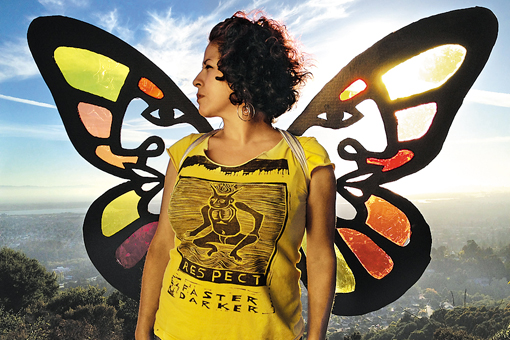Speaking out against injustice is nothing new for Favianna Rodriguez. In high school, the Oakland native led marches and walk-outs against California’s Proposition 187, a ballot initiative that prohibited undocumented immigrants from accessing state services. Today, Rodriguez’ butterfly imagery, together with the slogan “migration is beautiful,” has become a national symbol for the immigration reform movement, appearing in The New York Times and in pop performer and producer Pharrell Williams’ Voice of Art web series.
Growing up, Rodriguez was a star student whose Peruvian immigrant parents encouraged her to be an engineer or a doctor. After receiving numerous college scholarships, she enrolled at the University of California, Berkeley, to study architecture and ethnic studies—until her college career ended abruptly with an unexpected pregnancy at age 20. Rodriguez decided to have an abortion, an experience that was a “wake-up call” to start focusing her life on her passion: making art and combating social injustice. It compelled her to create art that would inspire other women not to be ashamed.
“Silence was costing us political power,” Rodriguez narrates in a “coming out” video about her abortion. “When you have that suffering in the shadows and you feel isolated […] you can’t really have a revolution.”
View a slideshow of Favianna Rodriguez and her artwork below.
That’s a message Rodriguez, now 36, has taken to heart in her outspoken advocacy on other issues, like immigration. In 2010, Rodriguez’ art appeared throughout the journey of four undocumented college students who walked 1,500 miles from Miami to Washington, DC, to bring public attention and support to the DREAM Act, which would have given legal status to many undocumented minors. The images, posters and videos she created for the students’ campaign—known as the “Trail of Dreams”—soon went viral.
“When people think of art, they think of something that belongs in a gallery—an object,” she says. “[But] art is part of a larger system of culture. I’m looking at ways to shift culture.”
Rodriguez’ work has reflected that shift, evolving from physical posters and screen prints (though she still does those, too) to multimedia campaigns that use memes, messaging and storytelling. While many think of the Trail of Dreams as an activist strategy, Rodriguez says it was also an artistic performance, carefully designed for maximum impact.
“We had to think through what [the students] were wearing, what the posters were, the use of photos—each visual element was critical to framing the broader narrative.”
In 2011, building on the momentum of the Trail of Dreams and in response to the anti-immigrant bill passed in Arizona the previous year, Rodriguez and three other artists co-founded Culture-Strike, a network of 180 visual artists, writers, filmmakers, musicians, and other culture producers who are using art to humanize the stories of immigrants in the United States.
CultureStrike’s butterfly images have appeared in protests and rallies from Washington, DC, to Arizona, on T-shirts worn by celebrities, on bumper stickers, and even at the 2012 Democratic National Convention in North Carolina. Other CultureStrike initiatives include a YouTube series called “Undocumented and Awkward” by the Dreamers Adrift Project, a comic book series by artist Julio Salgado, and an “Undocuwriting” retreat for budding writers.
CultureStrike has also shifted the paradigm around arts and activism in other ways. In addition to leveraging cultural narratives for broader change, it lobbies for the rights of artists themselves, such as fair compensation. Artists in the network receive professional development and training from Rodriguez and other creative professionals, as well as opportunities to showcase their work around the country.
Like the butterflies that adorn her work, the subjects of Rodriguez’ art cross boundaries. “We don’t live single-issue lives,” she says. “I’m the daughter of migrants; I’m a woman of color. Racism affects me; climate change affects me. The way I create art is through that lens.”
Art and slideshow photos courtesy of Favianna Rodriguez.






